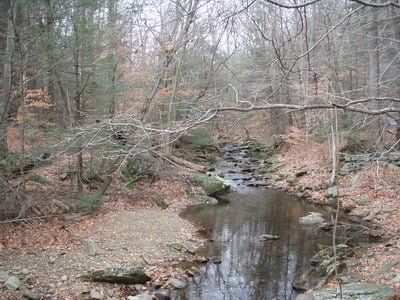In an earlier post, I discussed the Gorge Section of Big Hunting Creek – a great stretch of trout water. John and I decided to take a run out to Big Hunting and see what the upper section had to offer. In my earlier trip, I did a quick drive-by of this section and decided to ignore it in favor of more pool/plungy section in the gorge.
It was late December with the temperature hovering around 45 when we arrived. We parked at the big lot by the camp and hiked upstream following the wide trail to the left of the creek. The first thing that jumped out was the low flow. This was very skinny water! The water trickled listlessly from pool to pool, rock to rock without any energy or indication of life. Would there still be any trout left alive?
John was the first to discover the answer to that question when he found one of the few remaining deeper pools. He could see the trout holding in cold water and was quick to get one to take a bite at a pink colored nymph. Sadly, that was to be our only fish in this section of the creek as it was only pool deep enough to hold any fish.
The water continued to get skinnier and skinnier as we continued upstream. In my mind, the root cause is the flat gradient that causes the creek to spread out and dribble downstream. Without the rushing water characteristic of the gorge section, there are no cuts and runs that would create the deeper holding tanks for the trout.
Since it was December, we focused on using streamers and nymphs in our futile attempt to spur action from fish that must have moved into their winter mode of minimal activity. Although I failed to measure the temperature, I’m sure it was close to the 44 degree threshold that triggers dormant behavior. We assumed that the trout would not be interested in dry flies or other initiations focused on a surface presentation. We were careful to use 6X or 7X in recognition that the few survivors left in the creek would be pretty wise to the ways of the world after a summer of pressure.
We fished up this section for about 0.75 mi and stopped short of the parking area that marks the turn to the dam. We decided not to hike into the section above Cunningham Falls since we wanted to scout Beaver Creek – which is just a short run over the mountain from Big Hunting.

Although we did not do a ground based recon of the gorge, we could see that there was not much movement in the water as we drove past. Hopefully, the pocket water in that section is protecting the trout and will allow them to survive the drought, the winter and natural predators.
Big Hunting Creek Trout Fishing Bottom Line: Even when the water is higher, I will skip this section in the future. The structure of the stream in this area just does not look productive. Granted, after stocking, fish will hold whereever they can. If you believe that the stocking guys will follow the approach of minimum effort given the pressure of their schedule, it’s pretty easy to identify where the fish would be unceremoniously dumped into the water – just look for the few places where the creek runs right next to the road.
While higher water would produce a more holding pens for the trout, I’m sure they would be picked off pretty quick.
Getting There: Mapquest yourself to Thurmont, MD. In Thurmont, exit on 77N. The road picks up the creek on the right after about a mile and you enter the park soon after that.

John with our only fish of the day – a nice little brookie

The upper section of Big Hunting creek gets pretty skinny

Hard to imagine where a trout could hold over in water like this

Looks like a big pool, but it’s pretty shallow – maybe a foot deep.
Unless stated otherwise, this article was authored by Steve Moore


